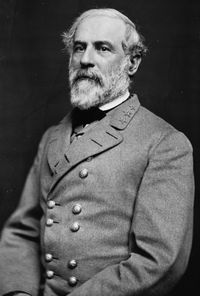 This was brought to my attention recently by a fairly heady student for a general U.S. History class in a public school. This student asked me how should Robert E. Lee’s success as a commander be measured? By how many times he persuaded inept Federal generals to leave the field and retreat, or by, say, casualty rates? This student had done some research and discovered that Lee, though commanding the field after many a battle, rarely inflicted a “higher” casualty rate. His casualties were almost always less and that was because he was almost always out-numbered.
This was brought to my attention recently by a fairly heady student for a general U.S. History class in a public school. This student asked me how should Robert E. Lee’s success as a commander be measured? By how many times he persuaded inept Federal generals to leave the field and retreat, or by, say, casualty rates? This student had done some research and discovered that Lee, though commanding the field after many a battle, rarely inflicted a “higher” casualty rate. His casualties were almost always less and that was because he was almost always out-numbered.
I have to admit I was taken back by such an intelligent analysis. From what I came up with, Lee suffered a 20% casualty rate while only inflicting a 15% rate; even when facing Grant the butcher, Lee suffered higher rates of casualties. For the South, which could not afford the rate of casualties Lee was inflicting, was Lee their best option as a commander? Should casualty rates be factored in when judging Lee’s performance?
I am pretty sure I have read somewhere arguments similar to this so I am in no way trying to present this as something original. What I would love is some feedback and pointing in the right direction to answer this excellent question by a student.
You could always point to this particular study:
http://www.amazon.com/How-Robert-Lee-Lost-Civil/dp/1887901337/ref=pd_bbs_sr_1/104-2939976-7680713?ie=UTF8&s=books&qid=1190141055&sr=8-1
The problem with this sort of analysis is that it gives too little credit to the moral effect of battles won and lost, regardless of casualty rates. Napoleon himself observed that the moral is to the physical as two to one, so I suspect that number-crunching isn’t quite the best assessment of a general’s capabilities.
Still, there are those, including the above author, who would contend that it is…
Dan I have not read that book and will get it. Thanks!! Anything online that anyone knows of? Statistics or articles that might be of use?